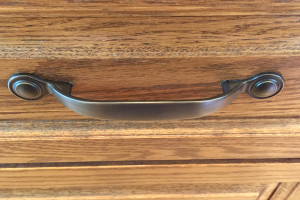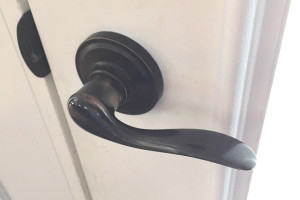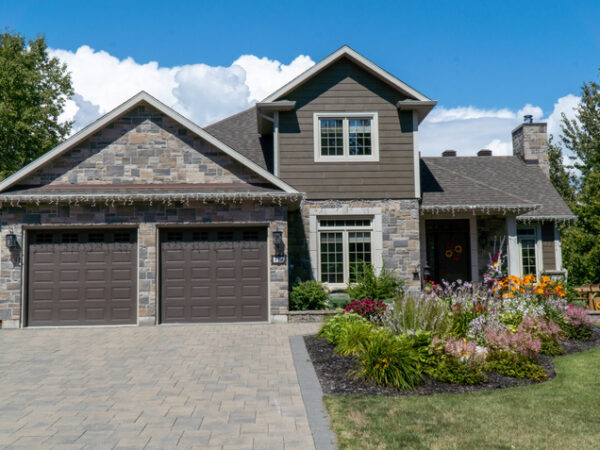Having renovated my kitchen a few years ago – and being fairly determined that I’m only doing this once – I was focused on making sure that the choices I made were right for my lifestyle not just now but also in the future. I’m not elderly yet, but within the life of this kitchen, I will be. Upgrading all of my appliances to energy efficient models will be easier on my utility bills every month but where they were situated in the new design was important.
My kitchen is a U shape and we designed the stove top on one side of the length of the U with the wall ovens on the opposite wall. I put the ovens in the wall so that I can have one of them at eye height and in a comfortable spot to deal with whatever is in it while the other doesn’t require too deep a bend to get items in or out. The sinks are at the bottom of the U. Up the middle is an island. As I move about my kitchen preparing food, the design helps by not having me go too far in any direction with a hot pan or pot. The island is not only a good prep spot but serves as a catch-all for hot pots coming off the stove or pans out of the oven. It’s also a good spot to rest a hand to help with balance as I age and the ‘galley like’ area created on either side of the island is narrow enough that I don’t need to reach very far to either the island or the cabinets to steady myself.
 When the time came to choose handles for the cabinets, I chose a wide D shape for every single cupboard top and bottom. Knobs were never in the running as they require movements that may be difficult for elderly hands. Some people advise the elderly to use pull style handles on drawers and while that’s not a bad idea, and certainly preferable to knobs, I feel that the open design of a wide D allows more options. As you can see from the design, a cabinet door or drawer could be opened with just one finger if need be but a grasped hand movement is not required. This design allows a piece of fabric to be tied around it if the user find that easier to manage or if an assist dog is used, the fabric could be grasped by the dog to open the door. Different colours of fabric can serve as reminders of what might be in the drawer for those who have memory challenges.
When the time came to choose handles for the cabinets, I chose a wide D shape for every single cupboard top and bottom. Knobs were never in the running as they require movements that may be difficult for elderly hands. Some people advise the elderly to use pull style handles on drawers and while that’s not a bad idea, and certainly preferable to knobs, I feel that the open design of a wide D allows more options. As you can see from the design, a cabinet door or drawer could be opened with just one finger if need be but a grasped hand movement is not required. This design allows a piece of fabric to be tied around it if the user find that easier to manage or if an assist dog is used, the fabric could be grasped by the dog to open the door. Different colours of fabric can serve as reminders of what might be in the drawer for those who have memory challenges.
Entry door handles are another challenge. Most are knobs, albeit large knobs, but knobs nevertheless and these can be difficult for aged hands to grasp and turn. Investigate lever style handles which can be opened by pushing down and don’t require a grasping movement. Increasing in popularity are door entry systems that don’t require keys rather a combination of numbers to unlock the door. I’m not a huge fan of this style for the elderly as memory problems may find your aged mother locked outside on a cold snowy afternoon. Remember that short term memory is the first area we find challenged in the elderly so new routines can be difficult to manage. Keyed entry doors are a part of everyone’s history and, therefore, ingrained in long-term memory so it makes sense to continue using a keyed entry. It also makes sense to have a spare key left with a trusted neighbour in case the main key goes missing along the way. Of great interest, and worth investigating, are the newer style of change locks that allow the user to change the locking combination to suit a new key. It doesn’t require a locksmith but it does require that the hardware be installed with this new system in place. The use of a small access key inserted into a specific location will reset the tumblers to accommodate the new house key instantly. This can be a handy tool if an elderly person loses keys, if renovations are being completed and several contractors may have had keys, if there is family upheaval or any number of other reasons.
sense to continue using a keyed entry. It also makes sense to have a spare key left with a trusted neighbour in case the main key goes missing along the way. Of great interest, and worth investigating, are the newer style of change locks that allow the user to change the locking combination to suit a new key. It doesn’t require a locksmith but it does require that the hardware be installed with this new system in place. The use of a small access key inserted into a specific location will reset the tumblers to accommodate the new house key instantly. This can be a handy tool if an elderly person loses keys, if renovations are being completed and several contractors may have had keys, if there is family upheaval or any number of other reasons.






Add Your Voice
0 Comments
Join the Discussion